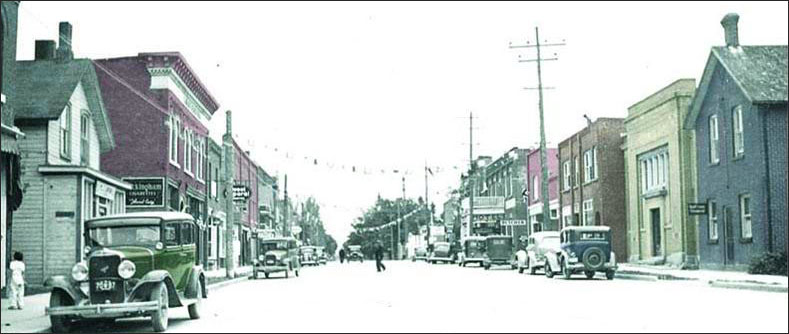
Anyone who has occasion to visit the Village of Elmvale now, without having been there for a few years, will be very much struck with the extensive improvements that have been made in that time.
The contrast is even more striking if we look backward to the beginning of this flourishing village. Previous to 1847, the entire flat portion of the Township of Flos, where Elmvale, Fergusonvale and Phelpston now stand, and all the district west to the Nottawasaga River, was a wilderness seldom trodden by white men.
In the year 1847 James Harvey came from the North of Ireland, and finding his way into the “bush” settled on the bank of the River Wye about a mile and a quarter east of where the village now is. His son, William Harvey, was superintendent of the township’s schools for fourteen years, (1858-71), and for many years filled the position of township clerk and treasurer.
John Ritchie, father of John, William and Thomas Ritchie, came with his family from Dumfriesshire, Scotland, and took up his abode near Harvey in 1849. William Ritchie and Edward Archer, with their families, followed in 1851. Nor did they themselves think there was any more land around them worth settling on, except what they had already taken up. About 1853, however, John McGinnis planted himself on lot 6, (north half) concession 8, which is now part of Elmvale, but called by the settlers at that time-the “Four Corners.” These were followed by the families of Strath, Graham, Paterson, Dickey, and a short time later by those of Drysdale, Lambie, Kerr and Malcolm.
 Gabriel French was also an early settler on the high ground, northeast of Elmvale, and numerous descendants of his still live in the neighbourhood. He died November 4, 1902, at an advanced age.
Gabriel French was also an early settler on the high ground, northeast of Elmvale, and numerous descendants of his still live in the neighbourhood. He died November 4, 1902, at an advanced age.
Years passed and these few settlers with occasional additions to their numbers continued clearing away the forest and making homes for themselves. About the year 1859, Thomas Stone opened out a store at the “Four Corners,” and a few years afterwards Joseph Lambie opened another. The first place of worship was the Presbyterian Church- built in 1864 on the rising ground about one-quarter of a mile east of the village. This was beside the graveyard, where so many of the first settlers are resting.
Elmvale received its first boom when the North Simcoe Branch Railway was built in 1879, and it has continued to grow ever since without any visible interruption. In 1887, G. Copeland & Sons built a large flour mill with a capacity of 150 barrels a day, and with an elevator attached to the mill, capable of storing 30,000 bushels of wheat.
Wm. Rowley, sr., contributed an article on the “Early Settlres of Flos,” to the Elmvale Lance of September 27, 1906. And the same paper in its issue of December 13, 1906, contained a sketch of the township’s history.
Elmvale was made a Police Village by a By-law of the County Council, in June, 1894

